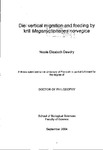Diel vertical migration and feeding by krill Meganyctiphanes norvegica
| dc.contributor.author | Dawdry , Nicola Elizabeth | |
| dc.contributor.other | Faculty of Science and Engineering | en_US |
| dc.date.accessioned | 2013-11-05T13:13:49Z | |
| dc.date.available | 2013-11-05T13:13:49Z | |
| dc.date.issued | 2004 | |
| dc.identifier | NOT AVAILABLE | en_US |
| dc.identifier.uri | http://hdl.handle.net/10026.1/2602 | |
| dc.description | Merged with duplicate record 10026.1/728 on 08.20.2017 by CS (TIS) | |
| dc.description.abstract |
The diel vertical migration (DVM) of zooplankton has been extensively studied and reviewed. Yet the controlling mechanisms for DVM are still uncertain, although several hypotheses, e.g. predator evasion, hunger - satiation, light avoidance, have been proposed. This is particularly so for krill. An important part of understanding krill DVM depends on explaining the factors which drive krill to the surface waters at night. lt is frequently speculated that krill migrate to the surface layers to feed. Although there is a vast literature on krill feeding (and the pattern of krill DVM) there has been little attempt to establish the role of feeding in DVM. Consequently, the main aims of this thesis were to further explore the mechanisms for krill DVM and also to explain the feeding strategy of krill in order to understand the role of feeding in DVM, using Northern krill Meganyctiphanes norvegica as a model system. These aims were achieved by examining the following: whether krill are selective feeders and also whether the morphology of the feeding basket constrains the food types that can be handled by krill; whether krill feed throughout DVM; the relationship between krill metabolism and feeding during DVM. Krill showed significantly greater feeding rates with larger food types compared with smaller food types and this size selection appeared to be at least in part related to the morphology of the feeding basket. Above all it seemed that krill were opportunistic omnivores and the food types handled by krill were affected by the morphology of the feeding basket. Krill also showed significantly greater feeding rates when offered food types available during the night compared with during the day. Gut contents from field caught individuals supported that krill did not feed extensively during the day as day caught individuals had significantly less stomach pigment content compared with night caught individuals. As krill appeared to not feed extensively on day time available food types it raised the question 'is there a cost to not feeding extensively during the day'. There did appear to be a cost to the lower daytime feeding than compared with the greater feeding shown both with night time available food types and from night captured individuals. It was hypothesized that krill may break down their respiratory pigment, haemocyanin (Hc) possibly for nutrition during these periods of low feeding during the day. In a field experiment, day captured krill had significantly lower He concentrations ([Hc]) than individuals captured at night. There was a clear cost to the lower [Hc] of day caught krill as concentrations of lactic acid in the haemolymph (indicating an O2 debt) were significantly greater in these day captured krill than compared with night captured krill. Consequently it seems that krill break down Hc during the day probably for nutrition because, for whatever reason, they do not feed extensively on the food types available to them in the deeper depths they reside within during the day. As they ascend to the surface layers at night, where they feed to significantly greater levels on the available food types, they appeared to rebuild their [Hc] and recover from the O2 debt they incurred during the day. Feeding experiments examining the recovery of [Hc] with food types available during either the day or night showed that after starvation krill recovered their [Hc] significantly quicker (and possibly to higher levels) with night available food types compared with day available food types. As they appear to be opportunistic omnivores it is proposed that this feeding strategy would facilitate the recovery of their daytime incurred debts. Krill appeared to show an asynchronously DVM and in particular female krill appeared to ascend to the surface layers of the water column earlier than males. In fact female krill showed a more extreme pattern of metabolism during DVM, with significantly greater [Hc] (ea. twice that of males) but also greater lactate debts with the breakdown of their Hc during the day. The earlier ascent to the surface layers and also the much greater [Hc] of females may indicate that they have greater metabolic demands than males. The asynchronous pattern of krill DVM supports the hunger - satiation hypothesis for DVM. If satiation is modified to also include the recovery of daytime incurred debts the findings of this thesis do indeed fit this hypothesis. A tentative model is proposed for krill DVM where krill break down their Hc during the day and then recover at night with feeding in the surface layers of the water column. | en_US |
| dc.language.iso | en | en_US |
| dc.publisher | University of Plymouth | en_US |
| dc.title | Diel vertical migration and feeding by krill Meganyctiphanes norvegica | en_US |
| dc.type | Thesis | |
| plymouth.version | Full version: final and full version as approved by the examiners at the time of the award of your degree | en_US |
| dc.identifier.doi | http://dx.doi.org/10.24382/4423 |
Files in this item
This item appears in the following Collection(s)
-
01 Research Theses Main Collection
Research Theses Main


